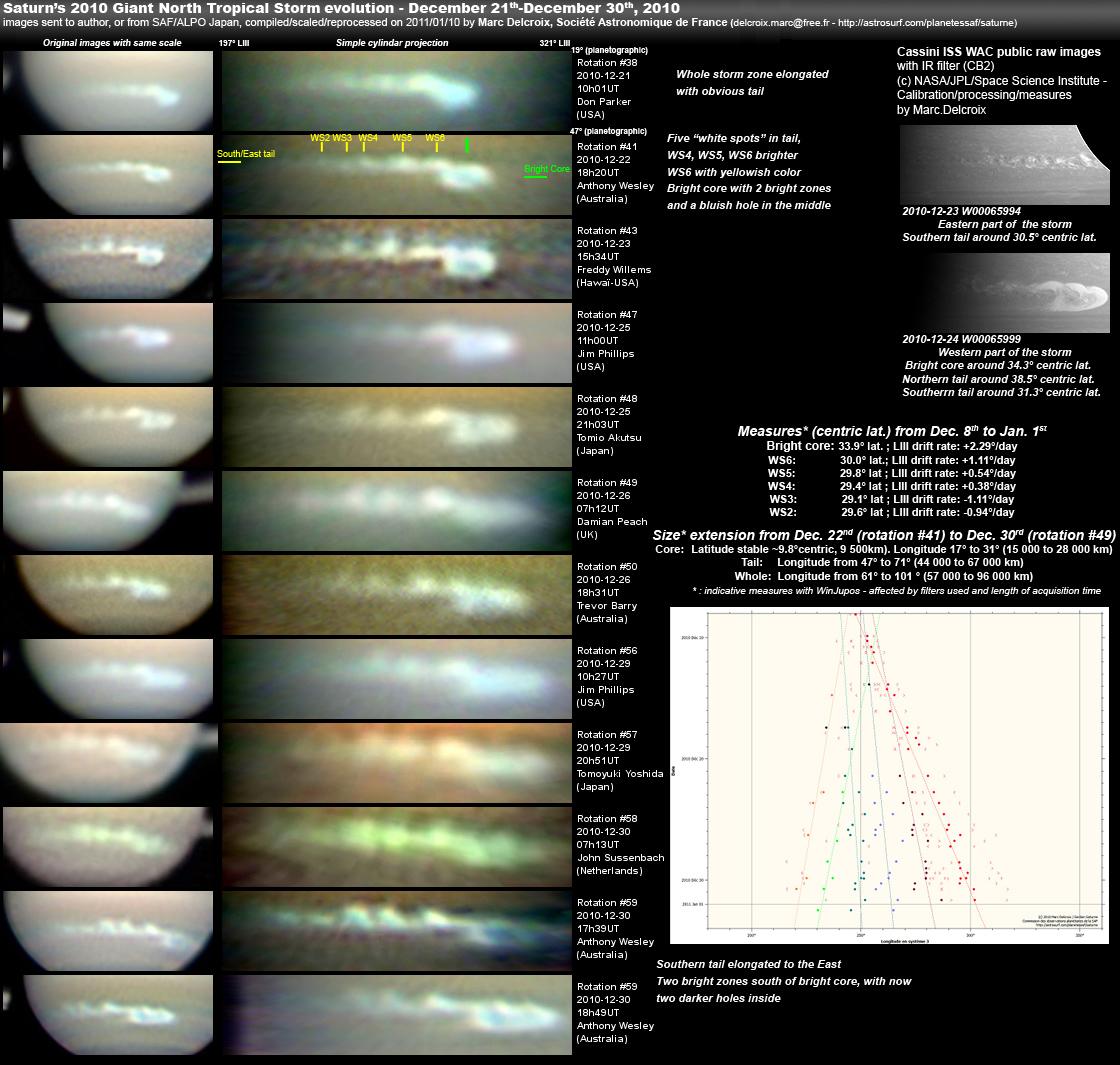| North Tropical Storm evolution from 2010.12.20 to 2010.12.30 by M.Delcroix |
Here is my second analysis of the images of this incredible storm till end of 2010
The storm evolved very rapidly. As soon as Dec. 22nd, in the splendid hi-res image of A.Wesley details appear, showing a bright core elongated in longitude, separated into 3 zones, one bright, one bluish and a second bright zone. North East of this zone, the storm shows the birth of a tail in a bright yellowish spot (WS6), followed by a long tail extending to the east (almost 50° in longitude) with 2 other bright spots WS5 and WS4, and two faint spots WS3 and WS2.
These spots can be followed on the best next images, WS2 and WS3 being more difficult to image though. The Cassini probe in 2 sessions offered us a very nice view of the western and eastern part of the zone, showing how complex the tail is and the 3 lobes morphology of the brightest part.
Only 8 rotations later, two others hi-res images from A. Wesley again show how the tail as been elongated to the east, and how the bright part drifted to the west while spreading. At this date the whole zone is spread over 100° in longitude (System III), that is around 100 000 km long (and 10 000 km in latitude) !
A detailed drift analysis shows that the spots in the tails have slow drifts (WS2 and WS3 eastward, WS4 and WS5 westward), while the beginning of the tail WS6 has a higher westward drift, and the bright core follows the westward jet in the North Tropical zone around 2.3° LIII/day. This makes this atmospheric feature a truly giant one on Saturn's scale.
This and the first analysis and ephemeris are available here:
href="http://astrosurf.com/planetessaf/saturne/saturn_2010-NTrZ-storm.html">http://astrosurf.com/planetessaf/saturne/saturn_2010-NTrZ-storm.html
Given the size of the storm, I've created additionaly to the ephemeris of the brightest part an ephemeris for the center of the all zone, so one can better plan his observations: http://astrosurf.com/planetessaf/saturne/doc/2010-NTrZ_storm_center_WW.txt

[Marc Delcroix Tournefeuille,France]
●土星の北熱帯の巨大嵐の発達、2010年12月20日〜2010年12月30日 これは2010年末までの驚くべき嵐の画像の2番目の解析である。嵐は非常に急速に発達した。12月22日になるとすぐに、Anthony Wesleyの素晴らしい 高解像度画像で詳細がとらえられ、経度方向に伸びた明るいコアが、明るいゾーン・ 青味がかったゾーン・第2の明るいゾーンの3つのゾーンに分割されていることが 分かった。これらのゾーンの北東には、嵐は明るい黄色がかった白斑(WS6)内部に 尾の誕生が見られ、さらに2個の明るい白斑WS5,WS4と2個の淡い白斑WS3,WS2を伴った 東に伸びる長い尾(経度でほとんど50度)が続いている。 これらの白斑は次の良好な画像にとらえられたが、WS2とWS3を撮影するのは難し かった。カッシーニ探査機の2つのセッションによって、ゾーンの東西の非常に 素晴らしい画像が得られ、尾や最も明るい部分の3個の丸い突起物がどのように 複雑かが分かる。 わずか8自転後の、再びA. Wesleyの2枚の別な高解像度画像から、どのように尾が 東に伸びたか、どのように明部が拡散しながら西に移動したかが分かる。この日 には、ゾーン全体は経度(体系3)で100度を超えていて、長さは約100,000km(緯度 方向に10,000km)である。 詳細なドリフト解析によれば、尾の最初の白斑WS6は大きな西方へのドリフトを 示しているが、尾の白斑は遅いドリフトを示し(WS2とWS3は東方へ、WS4とWS5は 西方へ)、明るいコアはDL3=約+2.3度/日の北熱帯の西方ジェット気流に従って いる。このことはこの大気現象を土星スケールの本当に巨大な現象にしている。 今回と最初の解析や天体暦は以下を参照。 http://astrosurf.com/planetessaf/saturne/saturn_2010-NTrZ-storm.html 嵐の大きさを伝えるために、最も明るい部分の天体暦にゾーンの中心の天体暦を 追加したので、この観測をより良く計画できるだろう。 http://astrosurf.com/planetessaf/saturne/doc/2010-NTrZ_storm_center_WW.txt Marc Delcroix http://astrosurf.com/delcroix 【日本語訳:伊賀祐一】
ALPO-Japan Latest
Saturn Section